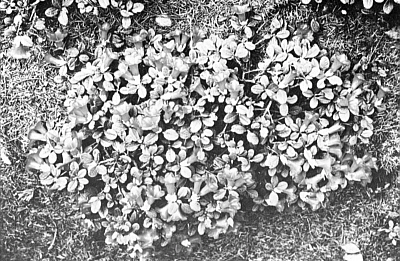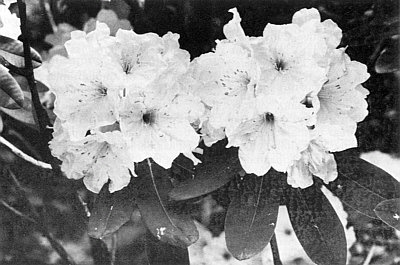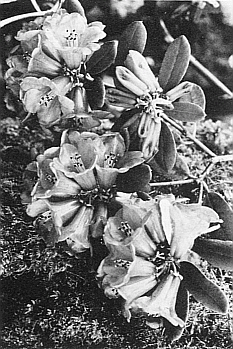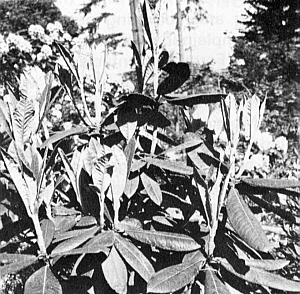QBARS - v31n1 George Forrest, Plant Hunter
George Forrest, Plant Hunter
Gwen Bell, Seattle, Washington
Plant hunters were remarkable men. George Forrest was such a man with many talents. It is now 103 years since he was born in Falkirk, Scotland, and 44 years since he died in China. He left a legacy to gardeners that can never be forgotten and, probably, can never again be equaled.
It is unfortunate that George Forrest did not write any books describing his seven journeys for if he had, they would rival any fictional adventure. We must rely upon his letters, on articles written for the "Gardeners" Chronicle" and to the lectures given, occasionally, between expeditions.
As a young man, George Forrest finished school and secured his first job in a chemist's shop. This work did not lead to a life's career, but he followed it long enough to acquire some familiarity with medicines and simple surgery. The experience proved useful in his future relationships with the Chinese, the Tibetans, and for his personal health, for we know that he contracted blackwater fever, typhoid and malaria during his journeys. It was the custom of his time for pharmacists to collect their own herbs. This stimulated Forrest's first interest in plants and botany.
When a small legacy fell to him, he decided to travel to Australia where he had relatives. Experience here served to toughen and harden him for the rigorous pioneering ahead. Strenuous riding over the sheep stations, hours spent with the felling axe and rugged work in the gold fields all contributed to his endurance. "He was heard to tell of the discovery of at least one gold nugget of substantial size."
In 1902, at age 29, he returned to Scotland. Because he liked plants and still preferred outdoor life, he applied to Sir Isaac Bayley Balfour, Regius Keeper of the Royal Botanic Garden at Edinburgh, for employment. The only job open was, as he put it, "a meager post in the Herbarium", indoor work. It would do, however, as a beginning. This indoor work with dried specimens was a far cry from his rough labors in Australia, so to keep in shape, he walked to and from work each day, a total of twelve miles and he stood at his table each day from 9:00 to 5:00. Week-ends were spent in hunting, fishing or hiking over nearby hills.
Reaching thirty years of age, George Forrest was described as short and stocky, a deep-chested man who preferred country life to the pleasures and worries of the city. His son tells us that he was a "meticulous man who shaved daily, bathed daily, but if he could not have a bath, had a very thorough wash - and that was no easy task in the wilds of Yunnan and Tibet". Usually, he wore a tweed jacket, "rather tight-at-the-knees breeches" and long stockings to match. Stout walking shoes or boots were essential and he preferred bow ties, soft hats and the color green. "George Forrest did not like plus fours. On the few occasions when long trousers were required, it did not suit him at all."
Opportunity arrived for George Forrest when he was 31. He was asked to undertake a botanical expedition to western China, financed by Mr. A. K. Bulley. Mr. Bulley owned a beautiful garden called "Ness" and a nursery firm called "Bees". He often wrote, requesting seeds from companies conducting business in far-off lands. So many firms responded that Mrs. Bulley was compelled to say, "The result was that Ness could boast the best international collection of dandelions anywhere." Clearly, Mr. Bulley could use the services of a plant collector.
In 1904, the richness and variety of ornamental plants in Yunnan and Tibetan highlands was largely unsuspected, although some exploration was underway farther to the east where Professor Henry, French missionaries and Ernest Wilson were in the field. Forrest planned to canvas the higher valleys, plateaus and mountains of southeast Tibet and northwest Yunnan searching for seeds of new and unusual alpines.
George Forrest reached the Yunnan Province in China by following old caravan routes through upper Burma. Late in August, he arrived in Tali-fu, the largest and most centrally located city in northern Yunnan. Tali-fu would be his base of operations.
Now picture a man, tough and honest, but with no previous experience of collecting seeds and plants in the wild, with no knowledge of non-English peoples, and with no associates or allies in this remote land. He must be his own organizer, foreman and accountant, must work at least eighteen hours a day estimating and acquiring equipment, arranging for stores and medicines and plot a course from very indefinite maps and charts. Quite a challenge!
One of his first decisions was to become a "bulk" collector. Forrest visualized covering vast areas, which of course, no man alone could hope to do while harvesting, searching, drying material and keeping up the clerical work. He began training natives to help him in the field, beginning with an interpreter and one or two Chinese. Later, he had twenty adept native collectors working for him. This highly successful training of native collectors was the key to his becoming the most prolific introducer of seeds, plants and herbarium material of all time. From home base, he would send out men in twos and threes to gather previously selected plants and seeds. They would hustle the harvest back to base or send it back by runners. Towards the end of his plant hunting years, he had collected 31,015 herbarium specimens alone, and his seeds were "measured by the pound, rather than by the ounce".
"Running mostly north to south flow four great rivers of east Asia, the eastern branch of the Irrawadi, the Salwin, the Mekong and the Yangtze Rivers squeezed into an area one hundred miles wide, higher ranges forming watersheds, deep valleys through which rivers flow. Difficult communications. Peculiar, as in many cases, upper valleys above 12,000 feet are comparatively undulating and have easy access once they reached sufficient altitude. Lower gorges often had precipitous sides." Forrest covered 50,000 square miles of territory such as this.
His natural ability to learn fair Chinese and the hill dialects allowed him to have direct communication with his men and with the hill people.
Forrest always carried a cumbersome old-fashioned camera and took great numbers of photos. "As you know," he wrote, "I am not the most patient of individuals. For the cultivation of patience, I recommend the photographing of alpines in Yunnan."
The borders of Yunnan and Tibet were never stable and there was constant strife. Letters home announced his escape from assassins. "When the British shocked the Tibetans by invading Lhasa, and the Chinese moved in after, trying to establish themselves on Tibetan territory, the Lamas rebelled. They murdered Chinese and killed missionaries, settling old jealousies. Forrest's group was camped at a mission station in the year 1905, as guests of two aged priests. On July 19, word came that the Lamas were massing to attack the helpless mission. Under a rising moon, the two priests, their small band of native Christians, their mules and Forrest's party set out toward safety. The Mekong River was in flood on their left and on their right towered the steep Mekong-Salwin Range. In the morning, villagers informed them that the enemy had cut off their retreat to the south and was closing rapidly. Late afternoon, a large party of armed men appeared on the track, running Indian file. Forrest gave the alarm and followers scattered abruptly in all directions. One of the priests was riddled by poisoned arrows, then jumped upon by Tibetans wielding two-handed swords. The little band was picked off one by one, or captured. Seeing that all was lost, Forrest fled eastward, scrambling over slippery logs. Later, returning to the track he rounded a sharp turn and there saw some of the hostile band running toward him. He could have used his guns, he was an excellent shot, but he knew that it would only signal those behind to the target, so he leaped desperately from the path, rolling down the steep, rocky slopes some two hundred yards, eventually finding sanctuary near a huge boulder by the river. For eight days, he struggled southward, traveling mostly at night, avoiding watch fires and Tibetan mastiffs. Once he was confronted by a group of his pursuers and wearily decided to make a last stand, or as a friend put it, to sell his life dearly. He raised his rifle to his shoulder, when suddenly his attention was attracted by what appeared to be the figure of Father Dubernard on a far hillside waving him farther downstream. He moved downstream and escaped once more. Later, he learned that Father Dubernard had been slaughtered three days before the vision!
On the ninth day, he found a friendly village. People there fed him, disguised him and guided him over the ridges, sometimes ascending to the snow fields at 17,000 and 18,000 feet, wading through miles and miles of rhododendrons and primulas."
Forrest was welcomed back in Tali-fu as one returned from the dead, and indeed, he had been reported dead three weeks earlier. Each of the seven journeys held tense, exciting moments.
During that eventful journey from 1904 through 1906, George Forrest kept letters moving from Yunnan to Scotland whenever possible to a young woman who had worked with him at the Herbarium. Following his return in 1907, he and Clementina Traill were married. Does the name Clementina recall to you R. clementinae , and the name Traill, R. traillianum ? The eldest of three sons relates that between treks, Forrest loved to read "westerns". He owned hundreds of these books, and the proprietor of the bookshop was "somewhat shocked at Mr. Forrest's taste in literature".
His third hunt was sponsored by J. C. Williams of Caerhayes and letters were exchanged that were like running conversations, some thirty pages long. This expedition produced a startling observation for that time. He wrote, "The rhododendron authorities at home talk about the impossibility of growing rhododendrons on limestone. I wish I had them here just now! to see R. chartophyllum and it's form, praecox, miles (no exaggeration) of bloom and every plant on pure limestone, many growing on the bare rock . . . this applies to almost all the species on the range. My experience is that plants growing in a limestone soil are more given to sporting than others. The Li-Chiang Range is purely and simply a solid block of limestone from end to end. He saw species there of R. neriiflorum , floccigerum , sanguineum , bullatum , ciliicalyx , crassum and yunnanense , along with dwarfer varieties of campylogynum , brachyanthum , trichocladum and intricatum . This account confirmed Wilson's observation about rhododendrons growing on limestone.

|
|---|
R. forrestii repens commemorates George Forrest |

|
|---|
Forest found R. diaprepes at 10,000 feet in southwestern Yunnan in 1913 Photo by Cecil Smith |
|
|
|||||
Once again he wrote, "Before going further, I wish to point out that above a certain altitude in this region of the Yunnan Province, the genus rhododendron is the dominant feature in the scheme of vegetation." It is no wonder that he collected more rhododendrons than any other plant, with primulas second. He contributed to thirty out of forty-three rhododendron series. The series to which he did not contribute are made up of the Himalayan, European and American species.
Forrest stressed that "nearly all rhododendrons in their natural environment are social plants. Very few are found as isolated plants." Two exceptions were R. griersonianum and spinuliferum . He found R. campylogynum on every one of his seven journeys. He described R. lacteum with very large bright yellow flowers and an unknown blue rhododendron, "a real blue", as he put it. The farther north he traveled the more rhododendrons he found. Dwarf rhododendrons covered acres and square miles. Eventually, he worked out a theory that somewhere farther to the north lay a protected valley that was the home, the Garden of Eden of the rhododendron genus. As far as we know he never reached such a valley, if, indeed, such a place existed.
Plant collecting overshadowed his other considerable talents as a geologist and as an observer and collector of bird, animal and insect life. One of his letters was certainly expressive. "Animal and bird life along the upper Salwin is conspicuous by its absence - an important matter for the traveler, who cannot count on replenishing his larder with game. On the other hand, the river banks at a low altitude, and where wholly sheltered from the north winds, have an almost tropical climate and vegetable and insect life is both vigorous and troublesome. Creatures with inconveniently long legs plunge suddenly into one's soup, great caterpillars in splendid but poisonous uniforms of long and gaily colored hairs arrive in one's blankets with the businesslike air of the guest who means to stay. Ladybirds and other specimens of coleoptera drop off the jungle down one's neck, whilst other undesirables insert themselves under one's nether garments. The light in the tent attracts a perfect army of creatures which creep, buzz, crawl or sting." There is more, but I'm sure you get the picture.
It was an event when Forrest looked upon R. giganteum for the first time. "One specimen stood seventy-nine feet tall and spread its branches forty feet. Measured at five feet above the ground, its girth was seven feet, nine inches. He felled one of these giants and sent a cross section back to the Royal Botanic Garden in Edinburgh. There it shows off its two hundred and eighty annual growth rings.
It is interesting that J. C. Williams paid Forrest a bonus for each new specie collected. It was his good luck that almost all species of that day were thought new and were not yet being merged by the botanists. We know that he was paid for, at least, three hundred nine un-described new rhododendrons, while he totaled some 5,375 different plant species introduced.
George Forrest did not like other collectors infringing upon his assumed territory. He refused to collaborate with Farrer, Ward or Rock when they were exploring and collecting nearby, and Farrer complained about the encroachment of "Forrest's Tentacles".
In mid-January of 1932, word reached Scotland that Mr. Forrest was dead. Most of his work had been completed and he was almost ready for his return home. He had gone out on the hills to hunt. Feeling ill suddenly, he called to his men for help, but it was too late. In two minutes, heart failure had ended his adventures forever. One account states that the people there honored him with a wreathe of white roses, the mourning color of China and another account describes the tall cross of red rhododendrons placed upon his grave.
So, George Forrest remains in that land that he pictured for us like this: "in the morning the sun, as it touches the top of the Mekong Divide, sends wide shafts of turquoise light down the side gullies to the river, which seems to be transformed into silver. The pines along the top of the ridges stand out as if limed by the hand of a Japanese artist. In the evening all the side slopes of the Mekong side are flooded with red and orange lights, which defy photography and would be the despair of a Turner. The traveler whose fortune it has been to explore the great rivers of this, our north-east Indian frontier will admit that the Salwin, while it is inhospitable, difficult and barbarous, far exceeds in natural beauty all the valleys of the sister rivers, the Yangtze, the Mekong or the Irrawadi.'"
George Forrest was a remarkable man!
BIBLIOGRAPHY
"George Forrest, V. M. H. " - Scottish Rock Garden Club
"Plant Hunting in China" - E. H. M. Cox
"Journeys & Plant Introductions of George Forest, V. M. H - Royal Horticultural Society



